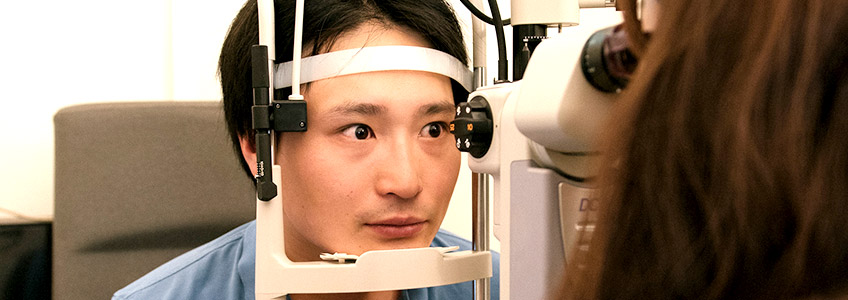Refractive Errors and Strabismus:
Myopia
(Short-sightedness) it is a very common condition characterised by clear vision for near distances and difficulty to see clearly objects that are distant.
Hyperopia
(Long-sightedness) a person that suffers from hyperopia usually can see distant objects but find difficulty seeing objects that are near. People can experience hyperopia differently however, as some can see clearly near and distant objects but present lots of annoying symptoms.
Astigmatism
Is the condition in which either the cornea or the internal lens of the eye (crystalline) has an irregular shape and this translates into blurred vision.
Presbyopia
Presbyopia is an age-related process due to the loss of flexibility/elasticity of the internal lens of the eye and its surrounding muscle fibers, which are responsible for the eye accommodation and focus for near vision.
Amblyopia
Known also as “lazy eye”, amblyopia is an eye developmental disorder that results when there is disruption to neural development of vision. It frequently arises as a result of uncorrected refractive error in early childhood or other visual hindrance such as strabismus. Often a combination of glasses, patching and eye drops are necessary to treat amblyopia.
Strabismus
Strabismus refers to eyes that are out of alignment. The eyes can be converged (crossed), diverged (outwardly deviated), vertically misaligned (one eye higher than the other) or torsionally misaligned (one or both eyes rotated inwardly or outwardly)
Eye Conditions and Diseases:
Anterior Segment
Cataracts
A cloudiness that develops in the crystalline lens of the eye causing decreased vision, increased glare sensitivity, and reduced contrast sensitivity.
https://1645-1653.captiv8online.com/animations/embed/one/t-t-u?
Keratoconus
Is an inherited disorder that consists in the conic degeneration of the cornea with thinning of its central part that causes bad visual acuity.
Dry eye
Dry eye syndrome is produced when the right amount of tears and/the right quality of them is not produced, resulting in eye discomfort and poor eye health.
Click here for a video with more information about dry eyes or go to our dry eye clinic page.
Conjunctivitis
Inflammation of the conjunctiva, often called "pink eye". The term conjunctivits is non-descript, and can be allergic, bacterial or viral in cause. The cause is important in the management. Bacterial and viral conjunctivitis are both very contagious and require measures to prevent spread.
Though bacterial conjunctivitis is self limiting, usually resolving in 7-10 days, use of antibiotics can hasten recovery and reduce the intensity of the discomfort and period of contagion.
Viral conjunctivitis is also self-limiting and recovers in two weeks, often made more comfortable with cold compresses and artificial tears, though it can result in long term complications with corneal inflammation, which can last months or even years. Though there is no topical eye drops approved for viral conjunctivitis, there is growing evidence that a Povidone-Iodine eyewash at early stage of conjunctivitis can reduce likelihood of corneal inflammation and significantly reduce the period and intensity of the conjunctivitis (Kawana et al. 1997; Monnerat et al. 2006; Trinavarat & Atchaneeyasakul, 2012; Wutzler et al. 2000).
Allergic conjunctivitis is managed with antihistamines and/or mast cell stabaliser eye drops, though sometimes require a short course of steroid eyedrops.
Eyelid bumps
Stye: A hordeolum (stye) is an acute, localised swelling of the eyelid that may be external or internal and usually is a bacterial (typically staphylococcal) infection or abscess. Most hordeola are external and result from obstruction and infection of an eyelash follicle and adjacent glands of Zeis or Moll glands. Internal hordeolum are a result of infection of meibomian glands.
Chalazion: Is a benign, painless bump or nodule inside the upper or lower eyelid. Chalazia (plural for chalazion) result from healed internal styes that are no longer are infectious. These cyst-like nodules form around an oil producing meibomian gland within the eyelid, resulting in red, swollen eyelids.
Pterygium
It is a triangular growth of tissue that starts in the conjunctiva and extends on to the cornea. Although non-cancerous, if it grows significantly, it can lead to corneal scarring which would affect vision.
Subconjunctival Hemorrhage
It is the bleeding that occurs when one of the tiny blood vessels of the conjunctiva, the transparent tissue of the eye, which covers the white part called sclera, bursts, thus, blood accumulates between the conjunctiva and the sclera. It usually resolves on its own in a couple of weeks.
Posterior Segment
Macula Degeneration
Age- related macula degeneration (AMD) is a degenerative retinal disease that causes a progressive loss of central vision due to a deterioration in the macula, located in the central portion of the retina. It most commonly affects people over 50 years of age.
There is a "dry" or atrophic form.
and a "wet" or exudative form.
Diabetic Retinopathy
Is a diabetic complication where the blood vessels of the retina are damaged, resulting in vision loss and blindness if not treated early.
Floaters
Floaters are perceived as tiny strings that float in the visual field and move when you move your eyes, they are located in the vitreous, a liquid substance inside the eye and can appear as transparent strings or grey or black dots.
Retinal Detachment
Occurs when the retina separates from the back of the eye producing partial or total vision loss, depending on how much of the retina has been detached. This is a medical emergency and must be treated immediately.
Glaucoma
Open Angle Glaucoma
The "silent thief of sight" that can cause slowly progressive peripheral vision loss if not detected early. By the time you are aware of any symptoms, there is already advanced vision loss. The eye’s drainage system is thought to become clogged, , resulting in chronic high intraocular pressure causing irreversible damage to the optic nerve of the eye. In normal tension glaucoma, where there is no increase in intraocular pressure, it is though that impaired blood flow to the optic nerve causes the nerve damage.
Angle Closure Glaucoma
Acute narrow-angle glaucoma occurs suddenly, when the colored portion of your eye (iris) is pushed or pulled forward. This causes blockage of the drainage angle of the eye, where the trabecular meshwork allows outflow of fluids. Obstruction to the fluid outflow can result in your eye's internal pressure (intraocular pressure or IOP) increasing suddenly and possibly damage the optic nerve that transmits images from the eye to the brain.
Acute angle-closure (closed-angle or narrow-angle) glaucoma can produces symptoms such as eye pain, headaches, halos around lights, dilated pupils, vision loss, red eyes, nausea and vomiting and is a medical emergency.
Secondary Glaucoma
Secondary glaucoma. Symptoms of chronic glaucoma following an eye injury could indicate secondary glaucoma, which also may develop with presence of eye infection, inflammation, a tumor or enlargement of the lens due to a cataract.
Pseudoexfoliative Glaucoma
Pseudoexfoliative syndrome (PXF) is a systemic condition characterized by the deposition of a protein-like material within the anterior segment of the eye, most notably on the anterior lens capsule, and other organs. Both genetic and environmental factors may play a role in its pathogenesis. It is commonly seen in older individuals and within certain ethnicities. This condition may present unilaterally and bilaterally and is known to be a major risk factor for secondary open angle glaucoma. Pseudoexfoliative glaucoma is seen in up to 50% of eyes with PXF
Pigmentary glaucoma
This rare form of glaucoma is caused by clogging of the drainage angle of the eye by pigment that has broken loose from the iris, reducing the rate of aqueous outflow from the eye. Over time, an inflammatory response to the blocked angle damages the drainage system.
You are unlikely to notice any symptoms with pigmentary glaucoma, though some pain and blurry may occur after exercise. Pigmentary glaucoma most frequently affects white males in their mid-30s to mid-40s.
Congential Glaucoma
This inherited form of glaucoma is present at birth, with 80 percent of cases diagnosed by age one. These children are born with narrow angles or some other defect in the drainage system of the eye.









